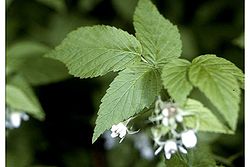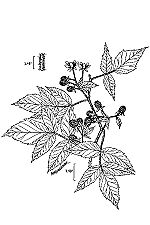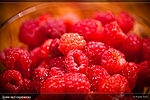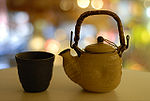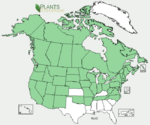American red raspberry
| American red raspberry |
|---|
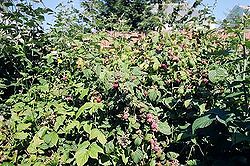
|
| Scientific Classification |
|
| Binomial Name |
|
Rubus idaeus |
| The perfect white flowers located in the upper axils |
The American red raspberry is a species of raspberry known by the scientific name Rubus idaeus which is best known for its fruit. There are many uses for the products of this plant including medicines and home remedies, nesting areas, cover, shelter, food for wildlife, and of course, the great tasting fruit that everybody loves! It must have a good source of water but that doesn't hinder it from growing around the globe.[1] [2]
Body Design
The American red raspberry is a shrubby plant which means that it is a woody plant that is smaller than a tree and has several main stems arising at or near the ground. It can grow to a height of six and one half feet. [3] The yellow-brown shredded bark [4] on the stems have little to no prickles and possesses alternate and pinnately compound (small veins branching off one large vein) leaves with three to seven serrate. The leaves are found in a broad, oval-like shape or in an oblong oval-like cordate shape and have a whitish color on the bottom. [5] [6]
The flowers themselves are white to greenish white. They are droopy [7]and grow either by themselves or in clusters of two to six and appear in the upper axils during the spring and the summer. [8]The fruit of the American red raspberry is small, about two centimeters long and wide. It is also round and red [9] when it matures later in the summer and becomes a delicious delicacy. [10]
The American red raspberry is mostly composed of biennial stems (canes) on a perennial rootstock. Primocanes, sterile first-year stems, form from buds below the ground and usually have leaves. [11] During the second year, floricanes, lateral branches, develop in the axils of the primocanes and bear leaves and fruit. A normal rootstock system for the American red raspberry usually has many primocanes to every one floricane. [12]
Life Cycle
The American red raspberry can reproduce from the root of the parent plant, from seed, and by pollination. The red raspberry is usually biennial, and each shoot passes through a easily interpreted stage during its two year lifespan. Vegetative shoots develop from the parent's roots or stems or they would develop as seedlings during the first year. Floricanes are produced the second year and they leaf out early and and grow rapidly. In the late summer, it produces fruit and after this, the cane and the leaves of of the old floricanes die. [13] A more detailed analysis of flowering at fruiting is compiled below.
Flowering:
In the American red raspberry, flower buds are initiated by temperature, genetics, and geographic location. Flowering is also influenced by the age of the plant and the date that the vegetative growth is terminated. Flower buds are triggered by lower temperatures, and short days. This usually occurs in the late summer or autumn. The more exact trigger of the flower buds is at an exposure to fifty-five degrees Fahrenheit and nine hours of daylight or fifty degrees Fahrenheit and sixteen hours of daylight. In spite of this, evidence suggests that higher spring temperatures promote sooner and faster flowering. [14]
Fruiting:
The maturation of the fruit begins quickly after flowering and the timing of the flowering greatly influences the timing of the fruiting season. The geographic location also determines the fruiting season. Annual variation of fruit ripening varies annually. As with flowering, fruiting takes place from the top of the floricane and moves downward. After the fruit ripens, the fruit spoils quickly. [15]
Uses
Along with just selling the great tasting fruit of this species for food, the American red raspberry makes a good leaf tea that is great for diarrhea, menstrual cramps, cystitis, or just something nice to drink. It is also good for gargling for a sore throat, or as something to use to wash sores, wounds, and skin rashes on the outside of the body. As [16]
As for professional medicinal properties, the American red raspberry can be used as an astringent, remedy for cardiac problems, or refrigerant. [17] An astringent is a substance or preparation, such as alum, that draws together or constricts body tissues and is effective in stopping the flow of blood or other secretions. [18]. A refrigerant would be an agent used to reduce heart fever. [19] Also, in the seventeenth century, Europeans thought of raspberries as an antispasmodic and they created a juice from it to help prevent vomiting. [20]
In the old days, when natural child birth was the only way to go, women brewed a tea made of the leaf of the red raspberry and drank it at least two months of the pregnancy to tone their uterus for labor. After the child was born, the mother would continue drinking the tea for several weeks to return the uterus to normal. [21]
As for wildlife, animals including grouse, birds, raccoons, coyotes, squirrels, skunks, and chipmunks eat the fruit. This plant also provides cover and shelter for many wildlife species and it serves the purpose of a good nesting spot for many birds. [22]
Cultivation
The Rubus idaeus L. is native to North America and grows from northern Europe to northwestern Asia. It is frequently found along the edges of swamps and bogs. [23] It is common to see this plant under the cover of trees. [24] It is also commonly found after burnings, clearings, or other disturbances. It grows great in a well-drained loamy environment in a sunny or somewhat shaded location. It is not picky about the pH texture of the soil and can survive a large range of it. [25] It is a very dominant plant in a many plant communities. It has even been known to be dominant in rocky and high elevations. [26]
If you are trying to maintain an American red raspberry bush, you should take into consideration the following:
1) Prune the branches to stimulate new growth and production of the fruit for the next season (every year). [27]
2) Occasional burnings would be helpful to stimulate new growth as well. [28]
3.) Since these plants grow so well in moist conditions, if there was a drought, you would need to keep watering the ground to make sure your raspberry bush gets enough water. [29]
References
- DeVries, Lynn. Red Raspberry. Medicinal Herb Info. Web. Accessed 22 May 2012.
- American Red Raspberry (Idaeus). gardenguides.com. Web. Accessed 23 May 2012. Author Unknown.
- Tirmenstein, D. 1990. Rubus idaeus. In: Fire Effects Information System, [Online].
U.S. Department of Agriculture, Forest Service, Rocky Mountain Research Station, Fire Sciences Laboratory (Producer). Available: Index of Species Information 23 May 2012.
